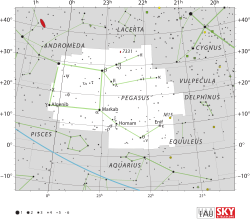Gliese 829
| Gliese 829 | |
 | |
| Observationsdata Epok: J2000.0 | |
|---|---|
| Stjärnbild | Pegasus |
| Rektascension | 21t 29m 36,81225s[1] |
| Deklination | +17° 38′ 35,8542″[1] |
| Skenbar magnitud () | +10,35[2] |
| Stjärntyp | |
| Spektraltyp | M3.0 Ve[3] |
| U–B | +1,31[2] |
| B–V | +1,61[2] |
| Astrometri | |
| Radialhastighet () | -25,0[4] km/s |
| Egenrörelse (µ) | RA: +1 007,13[1] mas/år Dek.: +377,27[1] mas/år |
| Parallax () | 147,4958 ± 0,0257[5] |
| Avstånd | 22,113 ± 0,004 lå (6,780 ± 0,001 pc) |
| Detaljer | |
| Temperatur | 3 400[3] K |
| Metallicitet | -0,13[6] |
| Andra beteckningar | |
| HIP 106106, G 145-40, G 126-4, GJ 829, GJ 829 B, GJ 829 A, HIC 106106, LHS 508, LSPM J2129+1738, 2MASS J21293671+1738353, NLTT 51370, PLX 5177, TYC 1668-637-1, UCAC2 38175716, UCAC4 539-143440, USNO-B1.0 1076-00695266, WISEA J212937.55+173839.8, Gaia DR2 1784473016438653056, Gaia DR3 1784473016438653056[7][8] | |
Gliese 829 är en dubbelstjärna[9] belägen i den mellersta delen av stjärnbilden Pegasus. Den har en kombinerad skenbar magnitud av ca 10,35[2] och kräver en kraftig handkikare eller ett mindre teleskop för att kunna observeras. Baserat på parallax enligt Gaia Data Release 3 på ca 147,5 mas,[5] beräknas den befinna sig på ett avstånd på ca 22,11 ljusår[1] (6,78 parsek) från solen. Den rör sig närmare solen med en heliocentrisk radialhastighet på ca –25 km/s.[4] Stjärnan kommer om ca 91 000 år ha nått sin närmaste position till solen med ett perihelium av 17,65 ljusår (41 parsek).[4]
Egenskaper
Primärstjärnan Gliese 829 A är en röd dvärgstjärna i huvudserien av spektralklass M3.0 Ve[3] med en effektiv temperatur av ca 3 400 K.[3] Stjärnan är ett dubbelsidig spektroskopisk dubbelstjärna av två röda dvärgar med en omloppsperiod av 53,22 dygn och en excentricitet av 0,374 [9]. Stjärnorna har en stor egenrörelse på 1,08 bågsekunder per år vid en positionsvinkel på +69,58°.[10]
Referenser
- Den här artikeln är helt eller delvis baserad på material från engelskspråkiga Wikipedia, Gliese 829, 26 januari 2022..
Noter
- ^ [a b c d e] van Leeuwen, F. (2007), "Validation of the new Hipparcos reduction", Astronomy and Astrophysics, 474 (2): 653–664, arXiv:0708.1752, Bibcode:2007A&A...474..653V, doi:10.1051/0004-6361:20078357, S2CID 18759600.
- ^ [a b c d] Ianna, P. A.; Whitman, W. R. (April 1984), "Parallaxes and proper motions from the McCormick Observatory List 45", Astronomical Journal, 89: 568–570, Bibcode:1984AJ.....89..568I, doi:10.1086/113550.
- ^ [a b c d] Lépine, Sébastien; et al. (2013), "A Spectroscopic Catalog of the Brightest (J < 9) M Dwarfs in the Northern Sky", The Astronomical Journal, 145 (4): 102, arXiv:1206.5991, Bibcode:2013AJ....145..102L, doi:10.1088/0004-6256/145/4/102, S2CID 117144290.
- ^ [a b c] Bailer-Jones, C. A. L. (March 2015), "Close encounters of the stellar kind", Astronomy & Astrophysics, 575: 13, arXiv:1412.3648, Bibcode:2015A&A...575A..35B, doi:10.1051/0004-6361/201425221, S2CID 59039482, A35.
- ^ [a b] Brown, A. G. A.; et al. (Gaia collaboration) (2021). "Gaia Early Data Release 3: Summary of the contents and survey properties". Astronomy & Astrophysics. 649: A1. arXiv:2012.01533. Bibcode:2021A&A...649A...1G. doi:10.1051/0004-6361/202039657. S2CID 227254300. (Erratum: doi:10.1051/0004-6361/202039657e). Gaia EDR3 record for this source at VizieR.
- ^ Rojas-Ayala, Bárbara; et al. (April 2012). "Metallicity and Temperature Indicators in M Dwarf K-band Spectra: Testing New and Updated Calibrations with Observations of 133 Solar Neighborhood M Dwarfs" (PDF). The Astrophysical Journal. 748 (2): 93. arXiv:1112.4567. Bibcode:2012ApJ...748...93R. doi:10.1088/0004-637X/748/2/93. S2CID 41902340.
- ^ GJ 829 (unistra.fr). Hämtad 2024-01-03.
- ^ "Ross 775". SIMBAD. Centre de données astronomiques de Strasbourg. Hämtad 2016-10-25.
- ^ [a b] Delfosse, Xavier; et al. (April 1999), "New neighbours. I. 13 new companions to nearby M dwarfs", Astronomy and Astrophysics, 344: 897–910, arXiv:astro-ph/9812008, Bibcode:1999A&A...344..897D.
- ^ Dawson, P. C.; De Robertis, M. M. (January 2005), "High Proper Motion Stars. IV. Radial Velocities of 166 Luyten Half-Second Stars", The Publications of the Astronomical Society of the Pacific, 117 (827): 1–12, Bibcode:2005PASP..117....1D, doi:10.1086/427790.












